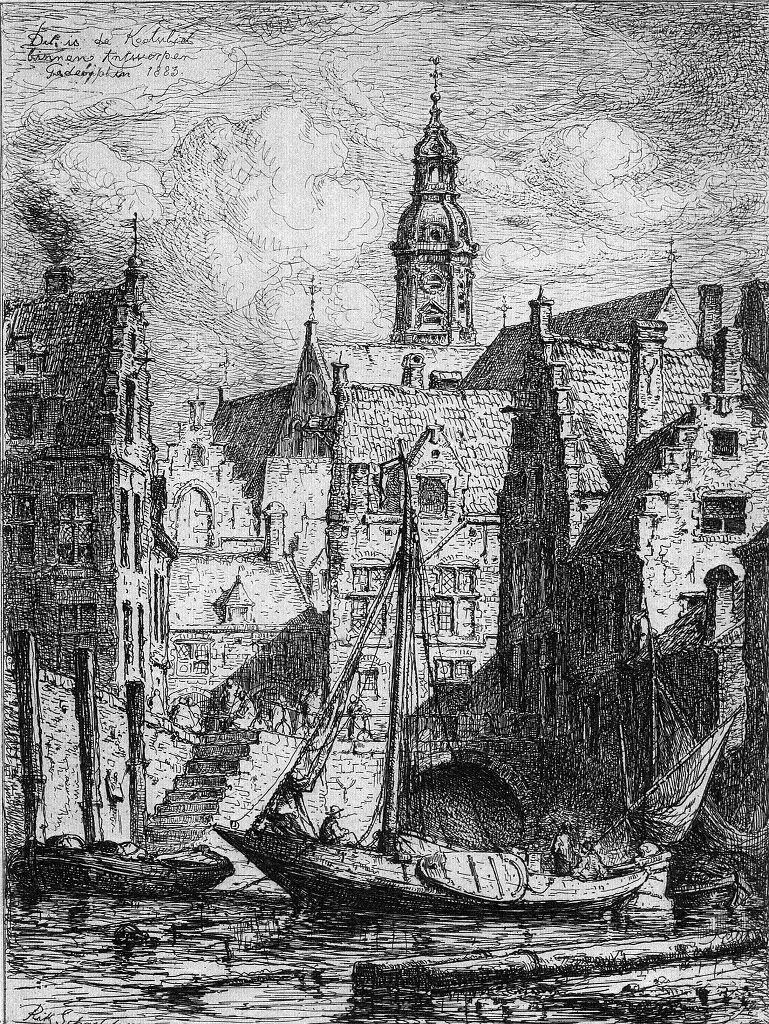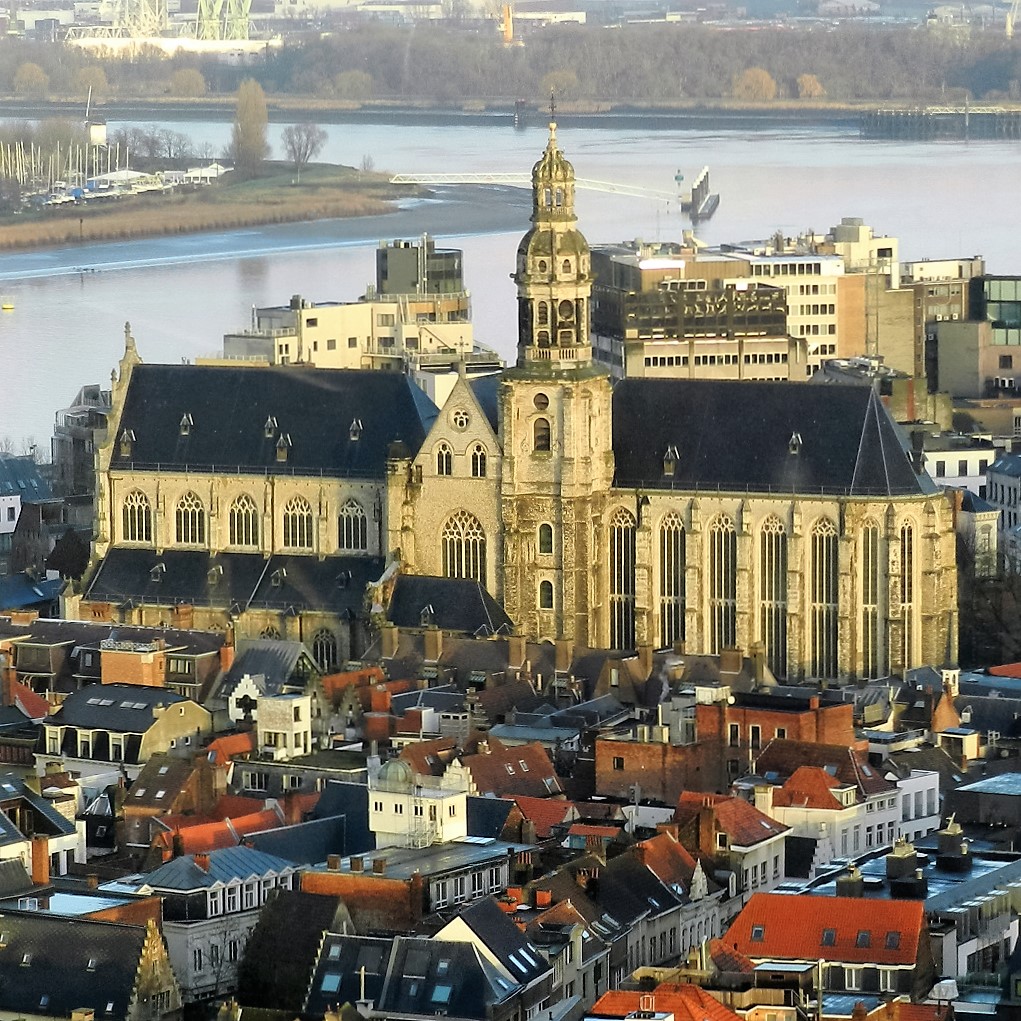Saint Paul’s, the Antwerp Dominican church, a revelation
Introduction
Whoever approaches Antwerp by the Scheldt, no matter how much he may be fascinated by the slender Gothic Our Lady’s spire, he cannot deny the impressive silhouette of the Baroque tower of Saint-Paul’s. In spite of urban developmental chaos resulting in inappropriate high-rise blocks built in the last few decades, even now, in the 21st century, this tower is a beacon in the Antwerp roadstead. The church owes its charm to the intrinsic tension with its surroundings. After all it always used to be the background of busy harbour activities at the quays of the Scheldt and it is still embedded in the old defiant Sailors’ quarter. But on the other hand it is protected from this hectic world by the picturesque and grandiose Calvary, the subdued cloisters and the monasteryComplex of buildings in which members of a religious order live together. They follow the rule of their founder. The oldest monastic orders are the Carthusians, Dominicans, Franciscans, and Augustinians [and their female counterparts]. Note: Benedictines, Premonstratensians, and Cistercians [and their female counterparts] live in abbeys; Jesuits in houses. ruins and garden, which surround it and make this church complex a timeless oasis of quietness.
The renown of this church is boundless because of its unequalled wealth of Baroque art. The Baroque furniture harmonizes wonderfully with the Gothic architecture. Painting is richly represented, not only by the Antwerp big three – Rubens, Jordaens and Van Dijck – but also by their colleagues. Even more abundant is sculpture. The astonishing craftsmanship of Artus I Quellin, Peter I and II Verbruggen, Willem I and II Kerricx shows in oak and marble in the altars and communionThe consumption of consecrated bread and wine. Usually this is limited to eating the consecrated host. rails, the choir stallsA series of seats, usually in wood, along the long sides of the choir. These seats are reserved for those who pray and sing the choir prayers. and the organ, the funeral monuments and the porches. The confessionals, with their dozens of life-size figures and extremely detailed wainscoting full of fantasy, are of extraordinary quality. The enormous sculpture garden around the Calvary is really unique. In a ‘live’ open air theatre a great Bible story is evoked.
It is less well known that this church thanks its existence to the Dominican order, whose monastery was an intellectual study centre. True to their motto on the high altarThe altar is the central piece of furniture used in the Eucharist. Originally, an altar used to be a sacrificial table. This fits in with the theological view that Jesus sacrificed himself, through his death on the cross, to redeem mankind, as symbolically depicted in the painting “The Adoration of the Lamb” by the Van Eyck brothers. In modern times the altar is often described as “the table of the Lord”. Here the altar refers to the table at which Jesus and his disciples were seated at the institution of the Eucharist during the Last Supper. Just as Jesus and his disciples did then, the priest and the faithful gather around this table with bread and wine. and to their patron Saint PaulOriginally, he was called Saul, he was a Jew with Roman citizenship and a persecutor of Christians in the period shortly after the death of Jesus. After his conversion, he became the main gospel spreader in what is now Turkey and Greece. He wrote letters to keep in touch with the Christian communities he had founded, and these texts are the oldest ones in the New Testament. Although he never met Jesus, he is called an “apostle”., the Dominicans went to preach ‘in faith and truth’ in town and its surroundings.
Because in the 19th century SaintThis is a title that the Church bestows on a deceased person who has lived a particularly righteous and faithful life. In the Roman Catholic and Orthodox Church, saints may be venerated (not worshipped). Several saints are also martyrs. Paul’s became a parish church, to replace the ramshackle Saint Walburga church, a part of the choirIn a church with a cruciform floor plan, the part of the church that lies on the side of the nave opposite to the transept. The main altar is in the choir. furniture that was linked with the monastery church, more specifically the rood loft, was pulled down. Thus a magnificent depth view on the sanctuary with its monumental high altar was created.
In 1968 a disastrous fire ravaged the entire complex. But difficulties create opportunities: thanks to the thorough restoration the Antwerpian can still be proud of ‘his’ Saint Paul’s church.
The first comprehensive description of Saint Paul’s is thanks to Aloïs Janssens’ pioneering work (1971), to which, during the restoration works, Raymond Sirjacobs added numerous new insights in publications of his own and in the unsurpassed magazine Sint-Paulus Info. The dynamic group ‘Saint Paul’s welcomes you’, supported by the Antwerp pastoral service for tourists, opens the deeper meanings of this church, which is more than religious heritage, to many a visitor.
In his striking imagery FatherPriest who is a member of a religious order. Paul Scheelen expresses his fascination for this extraordinary church patrimony like this: “Whoever enters Saint Paul’s church is struck by a rare harmony between Gothic and Baroque. If you are receptive to sacredness, which is tangible in this space, if you have an eye for the wondrous play of light and colour, which changes from hour to hour, you will come closer to yourself. Commonplace triviality will be lifted to a higher dimension. A couple of snails in a painting, two women brimming over with expectation – so many symbols that enclose and disclose the mystery of our existence. So many expressions of beauty that refer to this ultimate experience that makes man silent and makes him sigh: “God, how beautiful”. In this church building the greatest 17th century artists have given expression to the deepest source of life, which is called Love and surpasses everything that kills real life. The heartfelt cry of man and so also of God abounds in colours and sculpture, oak or marble. From the wealth of spiritual greatness and deeply humane emotions so much beauty ensues… A place of prayer and repentance or liturgy ringing with joy.”

Those who assist at a great orchestra massThe liturgical celebration in which the Eucharist is central. It consists of two main parts: the Liturgy of the Word and the Liturgy of the Eucharist. The main parts of the Liturgy of the Word are the prayers for mercy, the Bible readings, and the homily. The Liturgy of the Eucharist begins with the offertory, whereby bread and wine are placed on the altar. This is followed by the Eucharistic Prayer, during which the praise of God is sung, and the consecration takes place. Fixed elements are also the praying of the Our Father and a wish for peace, and so one can symbolically sit down at the table with Jesus during Communion. Mass ends with a mission (the Latin missa, from which ‘Mass’ has been derived): the instruction to go out into the world in the same spirit. on church festivals, live through the true reason of Baroque splendour: to uplift heart and mind to the Creator of all life, in good as well as in bad times. And do not be afraid when you are face to face with one of the many dogs carrying a torch in this church. Maybe this true companion of Saint Dominic knows how to set you too, present-day visitor, ablaze for God’s goodness, truth and beauty!
the author


- Saint Paul’s Church
- History and description
- Introduction
- Historic context
- The building history
- Saint Dominic
- Saint Paul
- The tower
- The architecture
- Floor plan and legend
- The sanctuary
- Chapel of the Holy Sacrament
- Our Lady’s chapel
- The mysteries of the Rosary
- Sermon, confession, music
- The mural paintings
- The treasury
- The Calvary garden
- Veemarkt gate
- Dominican pastoral activities
- Dominican convent
- The paintings in the cloisters
- Holy Cross Chapel
- SPK The weekly chapel
- Bibilography

